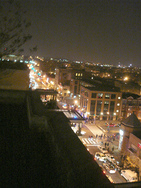Some restaurant limitations aren’t all bad
DCRA will stop issuing any permits for “restaurants, bars, diners, coffees shops and carry-outs” along the 14th and U commercial corridors because the area has reached the 25% maximum allowed by zoning.
Nobody wants to discourage investment in the city, especially in places that are historically underdeveloped. On the other hand, there are some good reasons why a percentage rule is a good one.
One of the most basic tenets of urbanism is to encourage a healthy mix of uses. While people normally think of “mixed use” as meaning the residential/commercial mix, it also applies to the type of commercial. Healthy city neighborhoods need a mix of commercial types just as much as they need a mix of land use types. If a neighborhood becomes overrun with too many of one type of storefront, that means there is less room for every other type.
If a commercial district leans too heavily on restaurants and bars, that means it probably doesn’t have enough hardware stores, clothing stores, book stores, barber shops, or home goods stores to meet the day-to-day needs of neighborhood residents. And neighborhood commercial districts that force neighborhood residents to travel elsewhere for their basic needs aren’t doing their job as neighborhood commercial districts.
This is something that private shopping malls have known a long time, and it’s one of the advantages they have over urban neighborhoods that led to the mall’s dominance in the latter part of the 20th Century. Ownership controls the exact mix of tenants in order to serve every need under one roof and reduce shopper’s desire to ever leave or go anywhere else. Every good mall has one or two sports apparel stores, one or two formalwear stores, one or two jewelry stores, etc. And of course a food court.
But unless it’s an older mall struggling to survive (and therefore not picky about who signs leases), there is never more than a couple of stores for any one niche. They want to hit every niche, so they can capture as many markets as possible. In the short term that means some potential tenants have to be turned away, but in the long term it makes the whole mall more healthy. It’s a form of delayed gratification that the major commercial developers of the country are very good at.
Of course, we don’t really want our neighborhoods to all look like shopping malls, lest they all look exactly the same. Been to one Lids and you’ve been to them all. But DC is generally a city that is overserved by restaurants and underserved by actual stores. And while it’s okay for some neighborhoods to develop specialties (such as 14th Street emerging as a furniture district), it’s in the city’s long term best interests to have as diverse a collection of retail as possible.
Zoning has always been a blunt tool, and maybe the zoning for Mid City needs to be more sophisticated. It’s entirely possible that 25% is the wrong ratio. But in discussing the matter we should remember that there are legitimately good reasons why livable neighborhoods don’t want every storefront to be the same.
 Cross-posted at BeyondDC.
Cross-posted at BeyondDC.
Update: Ryan Avent responds thoughtfully, suggesting that higher residential densities are a better way to encourage commercial diversity, and that as a regional specialty district for nightlife, U Street in particular increases investment in the whole city.

